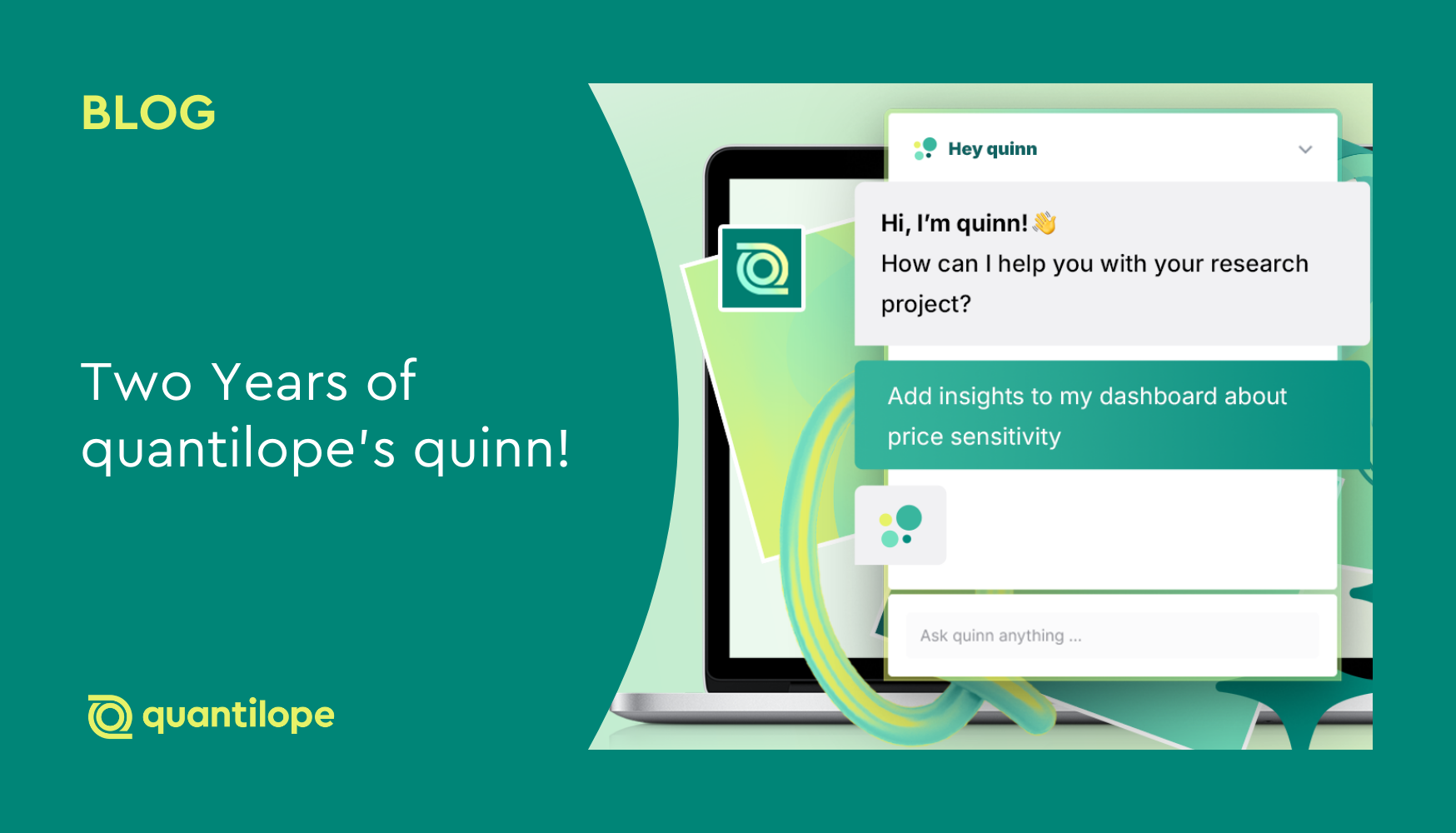As a consumer-facing company, there are few things more valuable than data-supported consumer insights. Consumer packaged goods (CPG) market research is one of the best ways to understand what consumers are buying, where they’re buying it, and why.
CPG brands (think: snacks, cleaning supplies, personal care products, etc.) that leverage market research are one step ahead in capturing a new customer base and retaining their existing one.
Table of Contents:
- What is CPG market research?
- Why CPG companies should conduct market research
- Types of CPG market research
- How to conduct CPG market research
- CPG market research example
- CPG market research with quantilope
What is CPG market research?
CPG market research is a way to understand consumer behavior in the consumer packaged goods market. Again, these are fast-moving products like food or household essentials that consumers are buying nearly every day. Many CPG shoppers remain loyal to certain brands while others are constantly looking for new products to try out - creating a huge opportunity for brands.
To retain your loyal customers and attract new ones, you need to know what their specific needs are (what features they look for, at what price point, in what kind of stores, etc.), and how your products can/already address them. CPG market research is the best way for CPG brands to earn valuable market share by way of catering their products to real consumer feedback.
Back to Table of Contents
Why CPG companies should conduct market research
Beyond retaining customer loyalty and attracting new customers to your brand, CPG market research can also help brands in their product development process as they create all-new products to bring to market.
Within a CPG market research study, respondents will provide feedback on the latest industry trends, package design preferences, e-commerce vs. in-store shopping preferences, and more, all of which help a brand develop and market its new product offering for success.
For example, let’s say a CPG brand wants to launch a new food and beverage product but is unsure about the flavor options. They can run a concept testing market research study to understand which product prototype most appeals to respondents. With these results, the brand either confirms a product choice based on a prototype winner, or, they go back to R&D for optimization of one (or both) concepts for further testing. Through this concept test, a brand is setting itself up for a successful product launch rather than a ‘guess and see’ approach which wastes valuable time and money in the long run.
Back to Table of Contents
Types of CPG market research
For any brand looking to run a market research study, they’ll first decide between a primary research approach or secondary research resources. Below are a few examples of each:
Primary CPG market research
Primary market research is any research study a brand creates on its own, which will produce its own unique dataset. Here are a few ways a CPG brand might use primary research methods for their own insights into the consumer packaged goods market:
Brand equity surveys
Brand equity surveys (often called brand health studies) are used to measure a brand’s performance from customers' perspectives. A brand will want to understand metrics around which demographics are using their brand, customer satisfaction toward their brand, how much ‘mental availability’ consumers have of their brand (i.e. how often consumers think of their brand in various contexts), and so on. Brand equity studies typically leverage quantitative data collection, though brands can explore topics further in qualitative focus groups or interviews.
Customer segmentation
Segmentation is one of the many advanced methodologies available to researchers and can be used to capture customer needs. A CPG brand will often gain value from segmenting its market into (say) consumers that prioritize single-serve packets to take on the go vs. large household consumers who need to buy in bulk. Understanding these different consumer needs can help the CPG brand effectively launch products that diversify its market share and satisfy a wider portion of the market.
Shelf testing
Many consumers shop in-store for their consumer packaged goods - at stores like mass retailers, grocery chains, and drugstores. Others shop on e-commerce sites like Amazon.com or Walmart.com for ease or convenience. Knowing who’s shopping where, and for what reasons, can inform a CPG brand of where to prioritize its resources - such as optimizing its in-store experience or focusing on its e-commerce user experience.
A shelf-testing study can further optimize those in-store (or even online) experiences by testing which products should be placed on the shelf, with what type of package design to catch consumers’ attention, and even where the shelf should be placed (if a CPG brand has the ability to make that decision within a store). Online shelf-testing can mimic a real store environment and capture consumer interest with tools like eye tracking.
Focus groups
As alluded to above, qualitative research (like a focus group) is a great way to expand on quantitative data findings. Led by a moderator, respondents are asked to provide verbal feedback to prompts and expand on them in detail. A moderator might ask: “What is it that you love about [CPG Brand’s] shampoo?” or, “What is it that attracts your attention to [CPG Brand’s] bottle on the shelf?”.
Focus groups are a great way to learn the ‘why’ behind the ‘what’. And in the world of fast-moving consumer goods (FMCG), knowing that ‘why’ could be what separates your successful business from ones that fall behind.
Secondary CPG market research
Secondary research (unlike primary research methods) is research that brands leverage from third-party sources. Aka, it’s research that already exists - such as syndicated research studies (including many of the types mentioned above), academic reports, or case studies.
Secondary research could be a great place for brands to start if they have no idea how to answer their business question at hand. It can give them a sense of direction in how they might want to set up their own primary research study and is often relatively cheap to attain (or sometimes, free!). Alternatively, some brands may leverage secondary research after they've completed their own study - to either confirm or supplement their own data findings.
Back to Table of Contents
How to conduct CPG market research
Related: 12 Innovative Market Research Companies & Agencies to Consider in 2026
CPG brands looking to conduct market research for their business should follow these key steps to ensure they gather thorough, high-quality, actionable insights:
-
Start by defining your research objectives: Outline the specific goals you hope to accomplish with your market research project. Examples of research goals might be to understand consumer preferences, evaluate a new product concept, or assess how well your marketing campaigns are performing.
-
Identify your target audience: Your target audience is the group of consumers you hope to reach, and eventually turn into loyal customers of your brand. Start by narrowing in on the specific consumer groups that make sense for your product or service. Consider elements like demographics, psychographics, and behavioral factors that are relevant to your research objectives.
-
Choose a research methodology: Once you’ve settled on an objective and an audience, you’ll have to decide how you want to collect your data. Common approaches for CPG market research data collection include surveys, focus groups, interviews, observations, or the data analysis of secondary research sources.
-
Design the research: With your research methodology in mind, it’s time to start building your research study, which could be a questionnaire, discussion guide, or observation protocol that (again) aligns with your research objectives. As you build your research, be careful to avoid common survey biases that could alter the outcome of your results.
-
Collect and analyze data: Next, choose a high-quality sample provider (or use your own supplied list of customers) and launch your survey into field! If you opt for a survey platform, you’ll often be able to analyze your results in real-time as you collect respondent completes. With other data collection methods such as traditional agency surveys, you’ll likely start your analysis once the final completes are in. As for qualitative interviews or focus groups, you’ll pick a date and invite respondents (whether in-person or virtually) to discuss your question guide. Depending on how you collect your data (or how soon you have access to it), you’ll then want to consider things like statistical testing and data visualization tools for analysis.
-
Interpret and report findings: After you’ve analyzed the research results, you’ll start to draw meaningful conclusions from the data around your brand and close competitors. You can gather these metrics into intuitive chart formats and prepare a final report of the key findings and recommendations to share with stakeholders.
-
Take action: Finally, it's time to put your market research findings into practice to inform future business decisions and strategies. Use the insights you’ve collected to improve your product development process, marketing approach, pricing strategies, distribution channels, and overall customer experience.
Back to Table of Contents
CPG market research example
To put the above steps into a more realistic context, let’s consider a case study with Oatly - the fast-moving consumer goods (FMCG) company that produces alternatives to dairy products (most familiarly, their Oat Milk product).
Oatly came to quantilope with the goal of shifting its positioning from a vegan-only lifestyle toward a more broad-reaching consumer base. To accomplish this, Oatly was able to quickly build its online survey within quantilope’s end-to-end platform to capture meaningful insights about its target audience.
The metrics informed the brand of actionable consumer groups and unmet needs for dairy alternatives.
Using these data findings, Oatly was able to establish new research benchmarks and begin planning a brand campaign that catered to these newly-discovered consumer groups.
As they reflect on their experience with the platform:
“For a company that moves as fast as we do, it’s essential to generate insights at equal momentum. quantilope enables us to do exactly that.“
-Sandra Schlicht, Business Insights Manager at Oatly
CPG market research with quantilope
For consumer packaged goods brands looking for real-time insights, advanced research methodologies, and the option between consultative support or DIY platform access, quantilope is the place.
quantilope caters to a variety of research needs within the CPG space - whether it be product development research, claims testing, A/B advertising testing, channel distribution analysis with TURF analysis, or customer segmentation (among many others), quantilope makes it as simple as a drop & drop of your chosen method into your survey, with fielding, analysis, and reporting all within the end-to-end platform.
If you’re ready to stop relying on gut feel when it comes to your strategic CPG business decisions, get in touch below, and let’s set up a demo!




.png)